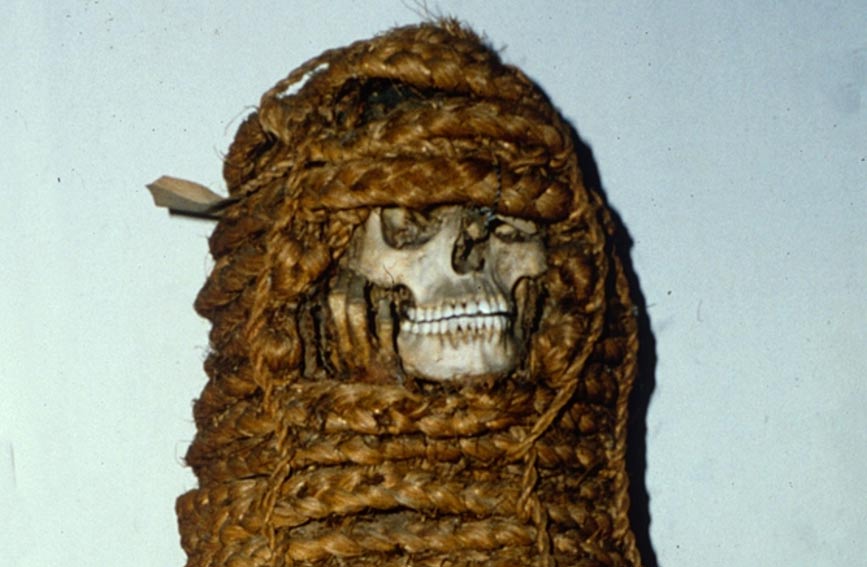Ancient Peruvian Mummy Surprises Researchers with Antibiotic-Resistant Genes
A mummy uncovered at the ancient site of Cusco in Peru has surprised scientists with what was contained in its gut. Genes linked to antibiotic resistance have been found in the Pre-Columbian mummy’s colon. These gene mutations occurred naturally, long before the introduction of modern medical antibiotics.
An international team of scientists studied the 11 th century mummy which was discovered in the ancient Inca capital of Cusco. Their research was directed at analyzing the microbiome of the remains which were naturally preserved in the cool, arid climate of the Andes Mountains, as reported by Discovery News.
The mummy, identified as a woman who was between 18 and 23 years old at the time of her death, had been brought to Italy in the late 19 th century, where it was donated to a museum and housed with 11 other mummies.
An autopsy revealed the young woman’s preserved heart, esophagus and colon were enlarged, indicating she may have suffered from chronic Chagas’ disease, a dangerous parasite spread through bloodsucking insects called Triatominae, or ‘kissing bugs’. This parasite still plagues six to seven million people worldwide today.
By sampling and identifying DNA from the mummy’s colon and feces, it was found that Chagas’s disease was what likely killed her, although she also suffered advanced heart disease, megacolon and megaesophagus. Scientists believe she was likely treated with early drugs, such as coca leaves, reports Discovery News. Upcoming results of toxicology tests on a braid of her hair may reveal more about what medicines or psychoactive drugs she might have taken.
![The ancient mummy [right] was a woman who died in the 11th century in Peru. Her gut revealed antibiotic-resistant genes. Altogether 11 such preserved mummies were in the museum collection.](https://www.ancient-origins.net/sites/default/files/styles/large/public/ancient-mummies.jpg?itok=lYtv2vp6)
The ancient mummy [right] was a woman who died in the 11 th century in Peru. Her gut revealed antibiotic-resistant genes. Altogether 11 such preserved mummies were in the museum collection. Credit: Gino Fornaciari. Courtesy of Maria Gloria Roselli/Museum of Anthropology and Ethnology of the University of Florence
Further analysis revealed another bacterial disease— Clostridium difficile (the origin of the C. difficile infection which causes diarrhea and colitis), and also some types of human papilloma virus (HPV).
Many of the antibiotic-resistant genes found in the ancient woman’s remains would have made treatment with modern antibiotics ineffective. These gene mutations are thought to have “occurred naturally in 1,000-year-old bacteria and are not necessarily linked to the overuse of antibiotics.”
Research findings have recently been published in the science journal PLOS One.
- Medieval Medicine: 1,000-year-old Onion and Garlic Salve Kills Modern Bacterial SuperBugs
- Amber encases a flea infected 20 million years ago with bubonic plague-type bacteria
- Russian scientists make progress on secret of eternal life

Basket mummies were prepared by treating them with smoke and then wrapping them and placing them in baskets. The baskets, which allowed the face to be seen, would be hung in family tombs. The arid, cold mountain climate naturally preserved the remains. Credit: Gino Fornaciari. Courtesy of Maria Gloria Roselli/Museum of Anthropology and Ethnology of the University of Florence
Study co-author and professor of history of medicine and paleopathology at the University of Pisa, Gino Fornaciari told Discovery News, “The mummy lay in a basket made of fibers which contained two drapes covering the body entirely. Only the skeletonized head and part of the hands were visible.”
The mummy had been prepared in accordance with ancient customs. Funerary practices at the times included arranging bodies in a fetal position and wrapping them in blankets, and securing them with cords, and placing them in baskets with handles for hanging in tombs. Other methods involved smoke-preserving mummies, much like the Kabayan Fire mummies of the Philippines.
- Mummified 18th century bodies give scientists clues about spread of TB
- Ancient mega-virus that does not resemble any virus on Earth is set to be revived
- Fire Mummies - The Smoked Human Remains of the Kabayan Caves

Kabayan mummy of the ancient Ibaloi people, Philippines. (Tadolo/ CC BY-NC-SA 2.0)
Antibiotic resistance today is a great concern. Researchers are sounding alarms for the need to reduce antibiotic use, for we soon may face a world where the patients are resistant to the medicines, described as a “silent tsunami facing modern medicine” by The Guardian this year.

A collection of naturally preserved mummies originating from the ancient site of Cusco, Peru. Credit: Gino Fornaciari. Courtesy of Maria Gloria Roselli/Museum of Anthropoogy and Ethnology of the University of Florence
While experts call for reduced antibiotic use, they’re also looking for sources of new antibiotics that we have not yet developed resistances to. It is hoped that identification of antibiotic resistance genes in ancient humans, such as found in the 11 th century Peruvian mummy, may give an understanding of diseases and treatments, and help in this search.
Featured Image: 11 th century Pre-Columbian mummy who has surprised scientists with antibiotic-resistant genes. Credit: Gino Fornaciari. Courtesy of Maria Gloria Roselli/Museum of Anthropology and Ethnology of the University of Florence
By: Liz Leafloor


















